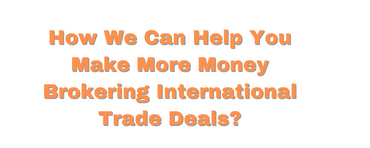Introduction:
Data analytics has emerged as a game-changer in the world of international trade. By harnessing the power of data-driven insights, trade brokers can make informed decisions, optimize their operations, and gain a competitive edge in the global marketplace. In this article, we will explore the role of data analytics in international trade decision-making, its impact on market research, risk assessment, and supply chain optimization, as well as key tools and techniques to leverage data analytics effectively.
H1: The Role of Data Analytics in International Trade Decision-Making
Data analytics plays a crucial role in international trade decision-making due to the following reasons:
- Informed Decisions: Data-driven insights provide trade brokers with valuable information and trends that enable them to make informed decisions based on market realities.
- Risk Mitigation: By analyzing relevant data, trade brokers can assess and mitigate various risks associated with international trade, including market risks, financial risks, and legal risks.
H2: Enhancing Market Research with Data Analytics
Market research forms the foundation for successful trade ventures. Data analytics can significantly enhance market research efforts by enabling trade brokers to gather and analyze relevant data effectively.
H3: Gathering and Analyzing Market Data
Data analytics tools enable trade brokers to collect and analyze market data, including consumer behavior, market trends, competitor analysis, and demand patterns. These insights help in understanding the market landscape and identifying potential opportunities.
H3: Identifying Market Trends and Opportunities
By leveraging data analytics, trade brokers can identify emerging market trends, consumer preferences, and untapped opportunities. These insights allow them to adapt their strategies and focus on high-potential markets and products.
H2: Risk Assessment and Mitigation through Data Analytics
Risk assessment is a critical aspect of international trade. Data analytics can aid trade brokers in identifying and mitigating risks more effectively.
H3: Analyzing Trade Risks and Predictive Modeling
Data analytics tools can analyze historical trade data, market conditions, and other relevant factors to assess trade risks. Predictive modeling techniques enable trade brokers to forecast potential risks and take proactive measures to minimize their impact.
H3: Assessing Financial and Legal Risks
By analyzing financial and legal
data, trade brokers can identify potential risks related to payment delays, compliance issues, or contractual obligations. These insights enable them to make informed decisions and mitigate financial and legal risks effectively.
H2: Optimizing Supply Chain with Data-Driven Insights
Supply chain optimization is essential for efficient international trade operations. Data analytics provides valuable insights for streamlining supply chain processes and improving overall performance.
H3: Streamlining Logistics and Inventory Management
Data analytics tools help trade brokers optimize logistics and inventory management by analyzing historical data, demand patterns, and transportation routes. These insights enable efficient inventory planning, reduced lead times, and improved customer satisfaction.
H3: Forecasting and Demand Planning
Accurate demand forecasting is crucial for optimizing supply chain operations. Data analytics techniques, such as time series analysis and demand modeling, enable trade brokers to forecast demand accurately, align inventory levels, and optimize production schedules.
H2: Key Tools and Techniques in Data Analytics for Trade
Several tools and techniques empower trade brokers to leverage data analytics effectively. Here are some key ones:
H3: Data Visualization and Reporting
Data visualization tools, such as charts, graphs, and interactive dashboards, help trade brokers visualize complex data sets and communicate insights effectively. Reporting tools automate the generation of reports, making it easier to share information with stakeholders.
H3: Predictive Analytics and Machine Learning
Predictive analytics techniques, combined with machine learning algorithms, allow trade brokers to analyze historical data, identify patterns, and make predictions. These techniques can be used for market forecasting, risk assessment, and supply chain optimization.
Conclusion
Data analytics has revolutionized the way international trade brokers make decisions and operate their businesses. By harnessing the power of data-driven insights, trade brokers can enhance market research, assess and mitigate risks, optimize supply chain processes, and ultimately drive business success. Embracing data analytics tools and techniques is essential for staying competitive in today's dynamic international trade landscape.
FAQs
Q1: How can data analytics improve market research in international trade?
A1: Data analytics provides trade brokers with valuable insights into consumer behavior, market trends, and competitor analysis. By analyzing relevant data, trade brokers can make informed decisions and identify market opportunities more effectively.
Q2: What are some common risks in international trade that can be assessed using data analytics?
A2: Data analytics can help trade brokers assess various risks, including market risks, financial risks, and legal risks. By analyzing relevant data and using predictive modeling techniques, trade brokers can identify and mitigate potential risks proactively.
Q3: How does data analytics contribute to supply chain optimization in international trade?
A3: Data analytics enables trade brokers to optimize supply chain processes by analyzing historical data, forecasting demand, and streamlining logistics and inventory management. These insights help in reducing costs, improving efficiency, and enhancing customer satisfaction.
Q4: What are the key tools and techniques in data analytics for trade?
A4: Key tools and techniques in data analytics for trade include data visualization and reporting tools, predictive analytics, and machine learning algorithms. These tools empower trade brokers to analyze data, visualize insights, and make data-driven decisions.
Q5: How can trade brokers get started with data analytics?
A5: Trade brokers can start by identifying their data needs, exploring available data analytics tools and technologies, and seeking training or partnering with data analytics experts. It's essential to define clear objectives and develop a data-driven culture within the organization.
============================================
Please reach out with your request using one of these ways:
- email: export@ramzisite.info
- Phone: +1 424 208 0297
- Telegram: https://t.me/+14242080297
- WhatsApp: https://wa.me/+14242080297
- FB Messenger: https://m.me/meramzi
- LinkedIn: https://www.linkedin.com/in/increasemynetprofits
To get more real life examples of successful Export transactions in a step by step manner, please read our Amazon Book (Mike Wilson & Ramzi Bouchrit), 7 Steps to Export Success: https://amazon.com/dp/B0B35HG9PC
Click Here and Visit Our Store





